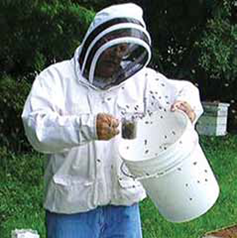Contributed by Dewey M. Caron
August is not a month for much bee work. It is too hot and colonies can be a bit testy. Keep water nearby and give them some supplemental shade in the afternoon if you are concerned. August however is the month to determine how the bees are doing with keeping a lid on varroa mites. August is when we begin to raise the bees that will rear the bees that make up the winter cluster. These bees MUST be healthy. Varroa mites must be under control or the hive will not overwinter. The end of the bee’s year is fast approaching, so re-queening, feeding, and disease management must be done ASAP. Healthy brood and ample nutrition are the keys. Hive conditions now will determine the odds of overwintering success.
Mite monitoring is good bee stewardship. It lets you know precisely how the bees are doing and how successful everything you may have done for mite management so far this season has helped the bees. Monitoring means taking the pulse of the colony – are they holding their own or are the mites getting to harmfully high levels? See
Mite monitoring can be done in a number of ways. Looking for phoretic mites on adult bodies or percent of drone brood cells with developing mites is highly intrusive as we have to open the hive but it also is not very accurate – it says the hive has mites but not how many mites? Using a sticky board is less disruptive, especially if you have a screen bottom board or bottom that has a built-in sticky board for monitoring, but is tedious in counting the mites, takes two visits (to put the boards in and then remove them) and, for some, difficult to count, especially with lots of hive debris. It is a measure of colony mite load. Washing adult bees of mites is a measure of colony mite intensity. It does necessitate entering the colony as we prefer to take a sample of 300 adult bees from 1-2 brood frames. It is however the best measure of how your bees and you with any mite reduction efforts are doing in resisting/tolerating mites. [for a review of mite sampling and what numbers mean, I suggest looking at my HONEY BEE BIOLOGY AND BEEKEEPING, revised edition, Chapter 19, pages 315-317.
See How To Sample Bees for a Varroa Mite Count.

